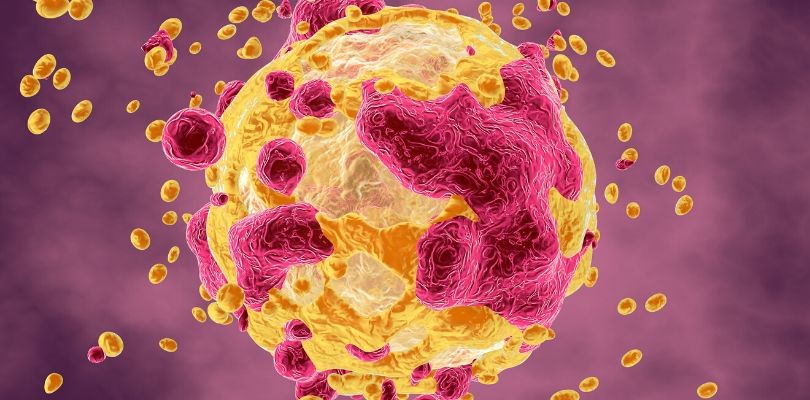What is Sarcoma?
What is sarcoma? Sarcoma is a general term for a rare type of cancer that begins in the connective tissues of the body including the bones, tendons, muscles, ligaments, cartilage nerves, blood vessels and fatty tissues. About half of sarcomas develop in the legs or arms, and about half develop in the neck and head area, internal organs, or in the back of the abdominal cavity, known as the retroperitoneum.
Types of Sarcoma
Sarcomas are categorized as either:
- Soft tissue sarcomas
- Osseous sarcomas
They are then further classified into more than 70 different sarcoma subtypes that are based on the surrounding tissue, the area of the body affected, or the type of cells that make up the tumor.
What to Know About Soft Tissue Sarcomas
Soft tissue sarcomas account for approximately 80% of sarcomas and develop in the soft tissues of the body including the muscles, nerves, fatty tissue, blood vessels, fibrous tissue, or deep skin tissue. Types of soft tissue sarcomas include:
- Angiosarcoma (affects the blood and lymphatic vessels)
- Gastrointestinal stromal tumor (affects specialized gut cells)
- Liposarcoma (affects fat tissue)
- Leiomyosarcoma (affects smooth muscle)
- Neurofibrosarcoma (affects nerve lining)
- Synovial sarcoma (affects stem cells)
- Rhabdomyosarcoma (affects skeletal muscle)
- Myxofibosarcoma (affects connective tissues)
- Fibrosarcoma (affects fibroblasts)
- Mesenchymomas (combines elements of other sarcomas and are very rare)
- Vascular sarcoma (affects blood vessels)
- Kaposi’s sarcoma (typically affects skin)
- Schwannoma (affects nerve tissue)
What to Know About Osseous Sarcomas
Osseous sarcomas develop in the bone and are much less common than benign bone tumors or secondary bone cancers. The most common type of osseous sarcoma is osteosarcoma. Other types of osseous sarcomas include:
- Ewing’s sarcoma (affects bone or soft tissue)
- Fibrosarcoma (affects fibroblasts)
- Chondrosarcoma (affects cartilage)
Causes of Sarcoma
The cause of most types of sarcomas remains unknown. Typically, cancer forms when mutations occur in the DNA within the cells of the body. These mutations may tell the cells of the body to grow and divide continuously and to continue living even though normal cells would normally die. The accumulation of abnormal cells may result in the development of a tumor. Cells from this tumor may then break away and spread to nearby and distant areas of the body, a process known as metastasis.
While the cause of sarcoma is unknown, various risk factors have been identified that increase of the risk of sarcoma, including:
- Radiation therapy increases the risk of developing a sarcoma in the future.
- Lymphedema (chronic swelling) increases the risk of a type of sarcoma called an angiosarcoma.
- Exposure to viruses, in particular herpes virus 8 increases the risk of developing Kaposi’s sarcoma in those with a weakened immune system.
- Exposure to chemicals, in particular industrial chemical and herbicides increases the risk of a type of liver sarcoma.
- Inherited syndrome, such as neurofibromatosis type 1 and retinoblastoma, increase the risk of developing sarcoma.
Cachexia and cancer are almost always related. Cachexia is what happens when someone with cancer loses weight without trying to. Learn more here,
Symptoms of Sarcoma
Signs and symptoms of sarcoma depend on the type and location of the tumor.
Soft tissue sarcomas may have the following signs and symptoms:
- A firm mass that may be seen or felt that is typically painless.
- Joint tenderness and swelling if the sarcoma is around a joint.
- Abdominal pain, vomiting, or bloody stool if the sarcoma is in the abdomen.
- Pain if the tumor is affecting nerves, muscles, or local tissues.
Osseous sarcomas may have the following signs and symptoms:
- Bone pain that may come and go but eventually becomes constant.
- Swelling.
- Palpable lump.
- An unexpected broken bone occurring with minimal or no trauma.
Treatments for Sarcoma
Treatment for sarcoma usually involves surgery to remove the tumor; however, other treatments may be used prior to, or after surgery. Determining which treatment is best will depend on the type of sarcoma, the location of the sarcoma, how aggressive the tumor is and whether it has spread to other areas of the body. Below we will discuss some treatment options for sarcoma.
Surgery
This treatment is aimed at removing all of the cancerous cells. Sometimes it is necessary to amputate a limb in order to remove all of the cancer, however, surgeons attempt to keep as much limb function as possible. In cases when the cancer cannot be removed without damage to important structures, such as organs or nerves, the goal of surgery shifts to removing as much of the tumor as possible.
Chemotherapy
These drugs are chemicals that are used to kill cancerous cells. Certain types of sarcomas are more likely to respond to chemotherapy than others.
Radiation
This type of therapy uses high-powered beams to destroy cancerous cells. Radiation may be external via a machine that moves around the body directing beams of energy towards the body, or internal where the radiation is placed in the body temporarily. In some cases, radiation may be used during surgery to destroy the cancer, a process known as intraoperative radiation.
Immunotherapy
This is a drug therapy that relies on the immune system to fight cancer. Immunotherapy drugs work by disrupting the normal response of the immune system to cancer cells.
Targeted Therapy
This is a drug therapy that uses medication to attack specific weaknesses in cancerous cells.
Ablation Therapy
This type of therapy uses electricity to heat, cold liquid to freeze, or high frequency ultrasound waves to destroy the cancerous cells
In Conclusion
Sarcoma is a rare and potentially life threatening tumor of connective tissue. Luckily, researchers have gained a better understanding of sarcoma recently and have identified the most effective treatment options depending on several factors including type and location of the sarcoma, as well as progression of the disease, which has resulted in an improvement in survival rates following treatment. As with any cancer, getting an early and accurate diagnosis and beginning treatment as soon as possible results in the best prognosis.







